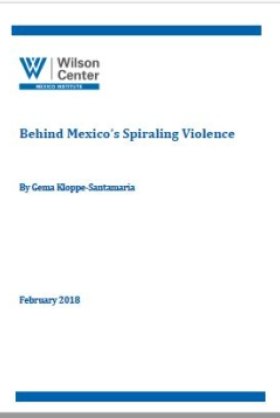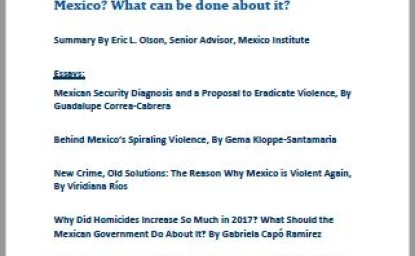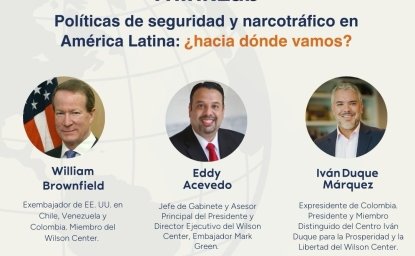Behind Mexico’s Spiraling Violence


With more than 25,000 murders and an estimated average of 69 homicides per day, 2017 marked one of the deadliest years in Mexico’s recent history of violence.
Most analysts have attributed the surge in levels of homicide to the divisions and violent confrontations within and between Mexican criminal organizations, particularly the Sinaloa cartel and the Jalisco New Generation cartel. Joaquin “El Chapo” Guzman’s extradition to the United States, which took place a year ago, has also been cited as an important reason behind Mexico’s homicide spike,
This of course is not the first time that criminal organizations’ power struggles have been brought forward as the reason behind rising levels of lethal violence. The dramatic increase in the country’s murder rate in 2008 and then again in 2011 were also attributed to the escalation of conflicts and rivalries amongst DTO members.
The fact that over the last two years at least one-third of homicides in Mexico have been linked to criminal organizations makes this argument credible. And yet, in previous years as in today, we need to be able to look beyond a narrative centered on criminal organizations. Specifically, we ought to be vigilant and alert, and incorporate both political and structural reasons that drive the country’s current state of insecurity.
Three key indicators of Mexico’s security crisis support the notion that today’s crisis is as much political as it is structural: forced disappearances, extrajudicial killings, and the alarming number of mass graves that have been discovered over the last few years. Each one of these indicators suggests that the violence Mexico faces today is the cumulative effect of the state’s clear failures, as well as its inadequate responses and pernicious practices in relation to the provision of security and justice. Even more, each one of these occurrences suggests that Mexico’s startling number of homicides cannot be fully explained without also looking at the state’s incapacity and unwillingness to prevent, investigate, prosecute, and punish criminal conduct.
The “state” that I am referring to, however, is not the impermeable and centralized entity that, for far too long, we had envisioned in Mexico. Rather, it is a state that has been, and continues to be, porous and decentralized in terms of how it relates to criminal organizations and how it deals with actors (both state and non-state) that profit from the reproduction of violence at the state and local levels.
Forced disappearances, which many families experience as a loss that can never be properly mourned, involve the criminal collusion of state actors who have pledged to protect the lives of citizens. Military and police personnel, in particular, have been accused of the abduction of thousands of people over the course of the last decade. Extrajudicial killings exemplify the ways in which Mexico’s spiral of violence entails the direct actions of state actors that in the name of “security” have engaged in gross human rights violations under the so-called war on drugs. And mass graves are a clear and painful expression of both the state’s weak investigative capacities and of the manifold complicities – at the state and municipal levels – that would seem to have to occur, in order for hundreds of bodies to be hidden away in plain sight of local communities as well as state authorities.
There are three lessons that the omissions and errors from the past years can offer to the current administration as well as to the future government that will take office in December of 2018. First, that the costs of coupling military actions with law enforcement activities grossly exceed its apparent benefits. Moreover, the need to modernize and reform the police is an unpostponable task, a task being greatly endangered by Mexico’s internal security law. Second, targeted and systematic prevention initiatives are needed and these should not be – as they have thus far been – easily discarded as a result of politicized budgetary decisions. And third, public officials need to overcome their reluctance to accept international assistance and cooperation in order to improve the state’s capacity to investigate and prosecute. The experience with the Interdisciplinary Group of Independent Experts between 2014 and 2016 vividly showed how this reluctance might translate into a lost opportunity to advance Mexico’s ability to deliver justice.
As Mexico approaches a chaotic and likely violent electoral year, citizens might hear candidates from the left and right offering single-cause explanations for the country’s homicide levels. As persuasive as they are, explanations that point at one culprit, be they criminal organizations or the federal authorities, obscure the complex network of complicities – political and criminal – that make violence possible.
Our responsibility as researchers and citizens is to elucidate and act upon these manifold factors and to explore viable, even if sobering, solutions.
Author

Mexico Institute Global Fellow; Assistant Professor of Latin American History at George Washington University

Mexico Institute
The Mexico Institute seeks to improve understanding, communication, and cooperation between Mexico and the United States by promoting original research, encouraging public discussion, and proposing policy options for enhancing the bilateral relationship. A binational Advisory Board, chaired by Luis Téllez and Earl Anthony Wayne, oversees the work of the Mexico Institute. Read more




